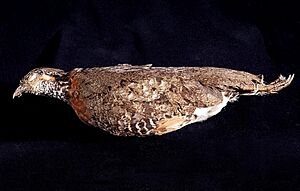Chestnut-necklaced partridge facts for kids
Quick facts for kids Chestnut-necklaced partridge |
|
|---|---|
 |
|
| Specimen at Naturalis Biodiversity Center | |
| Conservation status | |
| Scientific classification | |
| Genus: |
Tropicoperdix
|
| Species: |
charltonii
|
The chestnut-necklaced partridge (Tropicoperdix charltonii) is a beautiful bird that lives in the forests of Southeast Asia. You can find it in places like the Malay Peninsula and the island of Sumatra. It gets its name from the special chestnut-colored band around its neck. Sadly, this amazing bird is facing big problems. Its forest home is shrinking, and some people trap these birds. Because of these threats, the International Union for Conservation of Nature (IUCN) says it is a "vulnerable" species. This means it could become endangered if we don't protect it.
What Does It Look Like?
The chestnut-necklaced partridge is a medium-sized bird. It is about 26 to 32 centimeters (10 to 12.5 inches) long. Male birds weigh around 290 grams (about 10 ounces). Females are a bit lighter, weighing about 250 grams (around 9 ounces).
Here are some of its features:
- Its head and the back of its neck are brown with dark spots.
- It has a whitish stripe above its eye.
- Its throat and neck are whitish with brown streaks.
- A bright chestnut band crosses its upper chest.
- Above this band is a dark, almost black, collar.
- The lower chest is brown, and its belly and sides are buff-colored.
- Its upper body is brown with fine black and buff markings.
- The beak is a greenish-yellow color.
- Its legs are bright yellow.
Female birds are usually a little smaller than males. Their colors are also a bit less bright.
Where Does It Live?
This partridge lives in the tropical forests of the Thai-Malay Peninsula. It also lives on the island of Sumatra, especially in areas like Aceh and South Sumatra. It prefers to live in lowland evergreen forests. It can also be found in forests that are regrowing after being cut down, called secondary forests.
How Does It Behave?
Scientists don't know everything about the chestnut-necklaced partridge. However, they believe it usually looks for food in small groups. It probably eats things like seeds, berries, and termites.
We don't have many records of its breeding habits. But we do know about its call! It makes loud, clear whistle sounds. These sounds often come in pairs or groups of three. Sometimes, a male and female bird will call together, creating a duet.
Why Is It Vulnerable?
The chestnut-necklaced partridge is considered a "vulnerable" species. This means it is at risk of becoming endangered. Experts believe there are fewer than 10,000 adult birds left. The number might even be as low as 2,500.
The main reasons for its decline are:
- Habitat Loss: Forests where these birds live are being destroyed. This happens because of deforestation (clearing forests for other uses), logging (cutting down trees), and forest fires.
- Trapping: These birds are also caught and sold, which further reduces their numbers in the wild.
In Sumatra, where it used to be more common, the bird has been seen very rarely lately. Protecting its forest home and stopping illegal trapping are very important steps to help this beautiful partridge survive.


